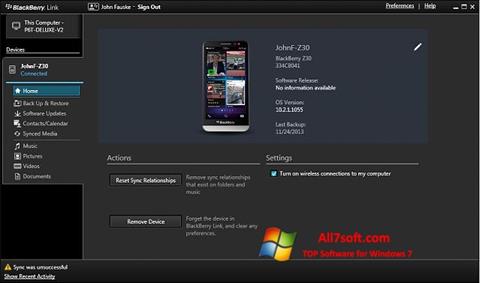

The surprises for me were in his networking tests. In short something like using 4Kb keys will be improved by greater word sizes until you get a larger than 4Kb CPU. Technically larger words sizes will improve their operation until you exceed their block size. Crypto and hashing functions are prime candidates for phenomenal speed improvements. I have to say the figures are as I suspected: for most things underwhelming. Makes me wish I had been doing the benchmarks. It even kind of runs desktop Linux programs… kind of.įascinating. How do you teach a kid not to rely on the cloud with all their stuff when the schools are even participating in the marketing? At least it’s not Apple I guess. Now, thanks to her school exposing her to them she has a Chromebook. I’ve been meaning to replace Raspbian with some other distro ever since but she really liked her computer otherwise so I kind of dreaded changing it.
#Blackberry link 64 bit update#
Sure enough it seemed like right after that the next Minecraft update came out and they dropped 32-bit support. I didn’t even realize at the time that Raspbian was 32-bit, even on x86. Her home directory is on the LAN so it was really no visible change to her. I installed Raspbian on the desktop so she could keep the same interface. I upgraded her to an actual desktop computer in the hopes of getting better performance. We even had the “real” Java edition of Minecraft on it for her. Some binaries don’t come in 32-bit anymore. Posted in Raspberry Pi Tagged benchmarks, Raspberry Pi 4 Post navigation Or you can go even further back if you like. If you are interested in performance versus the Pi 3, we looked at that earlier. However, it does seem like there are some real advantages to dumping the 32-bit operating system. VPN is another case where other things limited performance so the difference between the operating system size didn’t matter much.īenchmarks are always tricky, so your mileage - especially your real-life mileage - may vary. The 32-bit system could drop 268 packets per second, while the 64-bit dropped 557.

Dropping firewall packets was another big difference. RAM speed was a little better, but not much. But some things, like computing a hash, is something you probably do pretty often in normal usage, and the timing difference is pronounced.Ī few things were limited by things other than the CPU.

Some of the benchmarks, like Dhrystones, probably don’t relate much to real-life usage. If anything is surprising, it may be that the difference is so pronounced. It really shouldn’t be surprising that the 64-bit OS did better in nearly every test. So he installed a light version of 64-bit Debian and ran some benchmarks for the Raspberry Pi 4 running both 32-bit and 64-bit operating systems. However, the default operating system is still a 32-bit system and doesn’t take advantage of the Pi 4’s 64-bit capable CPU. Why not? You get a quad-core ARM processor, up to 4 GB of RAM, and a gigabit Ethernet port for $35 $35-55.


 0 kommentar(er)
0 kommentar(er)
